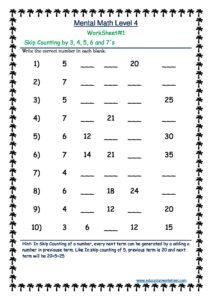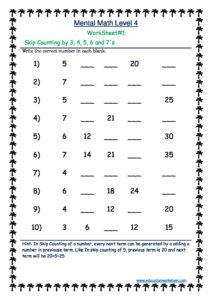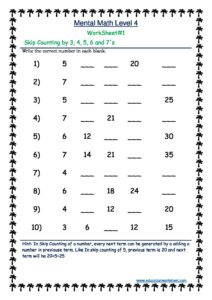Skip counting printable worksheets 3 to 7
Skip counting printable worksheets 3 to 7
Introduction
Skip counting is a fundamental mathematical skill that lays the groundwork for more advanced concepts such as multiplication, division, and number patterns. In this comprehensive guide, we will explore the art of skip counting from 3 to 7. Skip counting refers to counting numbers in a specific sequence, in this case, by multiples of 3, 4, 5, 6, and 7. Mastering this skill not only enhances numerical fluency but also improves problem-solving abilities. This guide will take you through the importance of skip counting, the sequences involved, practical applications, and strategies for effective learning.

Understanding Skip Counting
Skip counting by 3 to 7 is the process of counting numbers by a consistent interval, rather than one by one. It forms the foundation for more complex mathematical operations. When we skip count by numbers like 3, 4, 5, 6, and 7, we learn to identify patterns and relationships between numbers. This understanding is vital for multiplication, division, and algebra. Mastering skip counting allows individuals to approach math with confidence and ease.
Skip Counting by 3
Skip counting by 3 is an essential skill. It involves counting numbers like 3, 6, 9, 12, and so on. These worksheets will help learners become proficient in skip counting by 3, enabling them to handle multiplication tables with ease and recognize patterns in numbers that are divisible by 3.
Skip Counting by 4
Skip counting by 4 is another valuable skill. It involves counting numbers like 4, 8, 12, 16, and so forth. By mastering this sequence, students can quickly learn their 4 times tables, which is crucial for various mathematical tasks, including calculating areas and volumes.
Skip Counting by 5
Skip counting by 5 is perhaps one of the most widely used skip counting sequences. It includes numbers like 5, 10, 15, 20, and beyond. Proficiency in skip counting by 5 is a fundamental building block for understanding the base-10 system, making it an essential skill for young learners.
Skip Counting by 6
Skip counting by 6 involves counting numbers like 6, 12, 18, 24, and so on. It’s an excellent way to reinforce the understanding of multiplication by 6, as well as to identify even numbers in a skip counting sequence.
Skip Counting by 7
Skip counting by 7 includes numbers like 7, 14, 21, 28, and more. This sequence helps students recognize multiples of 7 and lays the foundation for understanding more complex mathematical concepts such as prime numbers and divisors.

Practical Applications
Skip counting isn’t just about numbers on paper; it has practical applications in everyday life. From calculating change when shopping to estimating time intervals, skip counting skills are incredibly useful. This chapter will explore how skip counting is used beyond the classroom, connecting mathematical concepts to real-world scenarios.
Strategies for Effective Learning
Learning skip counting requires a structured approach. This chapter provides strategies and tips to make the learning process efficient and enjoyable. It covers mnemonic devices, interactive activities, and practice techniques to help learners of all ages master skip counting from 3 to 7.

Conclusion
Mastering skip counting from 3 to 7 is a valuable mathematical skill that opens doors to a deeper understanding of numbers and their relationships. Whether you’re a student looking to excel in math or an educator seeking effective teaching methods, this guide has you covered. Skip counting is not just a mathematical exercise; it’s a key to unlocking numerical fluency and mathematical confidence. By following the guidance in this comprehensive guide, you can embark on a journey to mathematical mastery and problem-solving prowess.

